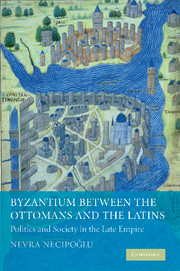Book contents
- Frontmatter
- Contents
- List of maps
- Acknowledgements
- Note on transliteration
- List of abbreviations
- Map 1 The Byzantine world in the fourteenth–fifteenth centuries
- Map 2 Byzantium and its neighbors, c. 1350
- Map 3 Byzantium and its neighbors after 1402
- PART I INTRODUCTION AND POLITICAL SETTING
- PART II THESSALONIKE
- PART III CONSTANTINOPLE
- PART IV THE DESPOTATE OF THE MOREA
- 9 The early years of Palaiologan rule in the Morea (1382–1407)
- 10 The final years of the Byzantine Morea (1407–1460)
- Conclusion
- Appendix I Archontes of Thessalonike (fourteenth—fifteenth centuries)
- Appendix II “Nobles” and “small nobles” of Thessalonike (1425)
- Appendix III Constantinopolitan merchants in Badoer's account book (1436–1440)
- Appendix IV Members of the Senate of Constantinople cited in the synodal tome of August 1409
- Appendix V Some Greek refugees in Italian territories after 1453
- Bibliography
- Index
10 - The final years of the Byzantine Morea (1407–1460)
Published online by Cambridge University Press: 07 December 2009
- Frontmatter
- Contents
- List of maps
- Acknowledgements
- Note on transliteration
- List of abbreviations
- Map 1 The Byzantine world in the fourteenth–fifteenth centuries
- Map 2 Byzantium and its neighbors, c. 1350
- Map 3 Byzantium and its neighbors after 1402
- PART I INTRODUCTION AND POLITICAL SETTING
- PART II THESSALONIKE
- PART III CONSTANTINOPLE
- PART IV THE DESPOTATE OF THE MOREA
- 9 The early years of Palaiologan rule in the Morea (1382–1407)
- 10 The final years of the Byzantine Morea (1407–1460)
- Conclusion
- Appendix I Archontes of Thessalonike (fourteenth—fifteenth centuries)
- Appendix II “Nobles” and “small nobles” of Thessalonike (1425)
- Appendix III Constantinopolitan merchants in Badoer's account book (1436–1440)
- Appendix IV Members of the Senate of Constantinople cited in the synodal tome of August 1409
- Appendix V Some Greek refugees in Italian territories after 1453
- Bibliography
- Index
Summary
When Theodore I died, he was succeeded by his nephew, Theodore II Palaiologos (r. 1407–43), the minor son of the Emperor Manuel II. This was undoubtedly welcomed as an opportune moment by the landowning aristocrats of the Byzantine Morea, who had endured obstacles, limited and only partially successful to be sure, but nevertheless threatening enough, to their quest for freedom and autonomy under the government of Theodore I. In a letter written probably from the Morea in the summer—fall of 1408, Manuel II highlights the unstable situation in the province, drawing attention to the traditional social disorders that were all too pervasive in the course of the young Despot's first year in power:
It seems that of old the land of Pelops was destined to look on its inhabitants' fighting with one another as preferable to peace. And nobody is so simple that in the absence of an occasion provided by his neighbor he cannot fabricate or invent one by himself. Everyone wishes to indulge his nature by making use of arms. If only those people had made use of them where they should, things would have been much better for them.
It may be inferred from this passage that the power-vacuum that ensued upon Theodore I's death provided an occasion for the aristocratic families of the Morea to apply their energies against each other with even greater vigor than before.
- Type
- Chapter
- Information
- Byzantium between the Ottomans and the LatinsPolitics and Society in the Late Empire, pp. 259 - 284Publisher: Cambridge University PressPrint publication year: 2009



